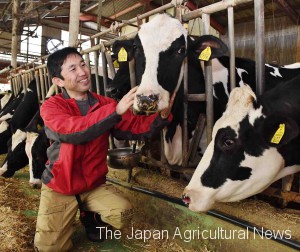Farmers of Kumamoto Prefecture are still working to recover, a year after the area was rocked by two powerful earthquakes which marked the highest rating of 7 on the Japanese seismic intensity scale.
In the Tateno district in the village of Minamiaso, where the large Aso Ohashi bridge collapsed, water supply remains cut off and farmers are having difficulty resuming their business. But earlier this month, one dairy farmer managed to take up farming again.
In Tateno, farmlands and water pipes were damaged in the earthquake that hit the region in the early morning of April 16 last year, following one on April 14. Nearly a year after, on April 11, 45-year-old Yasunori Otsuka shipped raw milk for the first time since the disaster.
“This is the first step that I have long been waiting for,” Otsuka said with a smile, looking into the eyes of a cow that he newly purchased.
Although his cowshed and 26 cows did not suffer any damage from the earthquakes, he had great trouble taking care of the cows after the disaster as the water supply was suspended.
One day, he saw his cows rush to drink water he delivered and one of them getting stuck in a fence and being injured because it was in such a hurry. He thought he couldn’t go on like this any longer and sold all of the cows in May. “I was relieved to see that they no longer have to suffer,” he said, adding that he was too stressed to feel sad about parting with them.
From then on, he spent his time cleaning the cowshed, but then he noticed that his hands, which used to be rough and work-hardened, were getting smooth. He felt sad and realized that dairy farming is what he wants to pursue.
He was also encouraged by the prefectural dairy farmers’ association and fellow dairy farmers. Since the beginning of this year, he began buying heifers, and on April 9, he could purchase 12 milking cows at a discount from a dairy farmer in the city of Aso, Kumamoto. Currently he owns 28 cows, more than what he had before the disaster. He obtained water supply by bringing two one-ton tanks of water on a dump truck every day from the neighboring town of Ozu.
“I’m determined to continue dairy farming here for the next 30 years,” Otsuka said, expressing happiness that he could again engage in dairy farming after nearly a year.
Meanwhile, other farmers are still far from recovery, mainly due to the lack of water supply.
Kinouchi Farm, which had been offering farming experience tours on a 17-hectare land close to the collapsed bridge, suspended its major business of strawberry growing after the disaster. Although it keeps growing potatoes in a small piece of land, its damages totaled nearly 300 million yen.
Many local residents of Tateno had been engaged in rice farming, but no rice has been planted there since the earthquakes. Rice fields and other farmlands are now filled with sand and gravel used for rebuilding the bridge, and the rich natural landscape of the district is now lost.
Works are going on to rebuild the water supply infrastructure to revive people’s lives and farming as soon as possible.
According to the Ministry of Agriculture, Forestry and Fisheries, the total amount of damages caused by the two earthquakes reached 179.3 billion yen, mainly in Kumamoto. The biggest damage was the collapse of barns, totaling 46 billion yen with 11,418 cases reported, followed by damages to a total of 332 hectares of crops amounting to 380 million yen and 325,387 deaths of chickens and cows worth 530 million yen.
Farmlands were destroyed at 11,696 locations in the Kyushu region, damages totaling 27.8 billion yen, and damages totaling 43.4 billion yen were reported at 5,260 farming facilities including reservoirs and waterways.


